
Myrtaceae, the myrtle family, is a family of dicotyledonous plants placed within the order Myrtales. Myrtle, pōhutukawa, bay rum tree, clove, guava, acca (feijoa), allspice, and eucalyptus are some notable members of this group. All species are woody, contain essential oils, and have flower parts in multiples of four or five. The leaves are evergreen, alternate to mostly opposite, simple, and usually entire. The flowers have a base number of five petals, though in several genera, the petals are minute or absent. The stamens are usually very conspicuous, brightly coloured, and numerous.

Baeckea is a genus of flowering plants in the myrtle family, Myrtaceae, all but one endemic to Australia. Plants in the genus Baeckea are shrubs or small trees with leaves arranged in opposite pairs, white to deep pink flowers with five sepals and five petals, and five to fifteen stamens that are shorter than the petals.

Thryptomene is a genus of flowering plants in the family Myrtaceae and is endemic to Australia. Plants in the genus Thryptomene are shrubs with small leaves arranged in opposite pairs and white or pink flowers. About forty-seven species of Thryptomene, occurring in all Australian states and the Northern Territory, have been formally described.

Calytrix is a genus of about 83 species of flowering plants, commonly known as star flowers, in the family Myrtaceae and is endemic to Australia. Plants in the genus Calytrix are small to large shrubs with small, spreading and more or less round leaves, the flowers arranged singly in leaf axils. The flowers are bisexual with 5 overlapping sepals with a long awn, and many stamens.
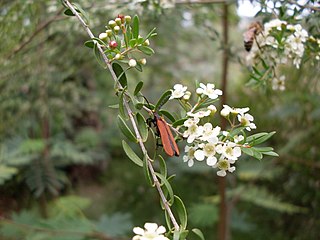
Sannantha pluriflora, commonly known as tall baeckea, is a species of flowering plant in the myrtle family, Myrtaceae, and is endemic to continental southeastern Australia. It is a shrub or small tree with lance-shaped to elliptic leaves, and groups of two to nine white flowers arranged in umbels in leaf axils.
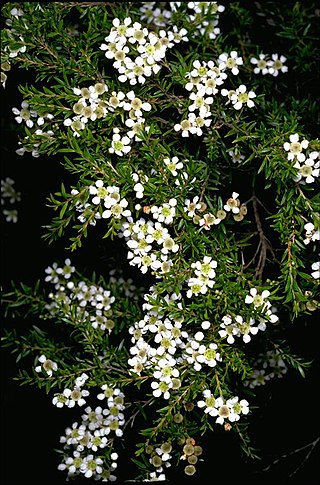
Sannantha similis is a species in the myrtle family, Myrtaceae and is endemic to eastern Australia. It is a shrub with narrowly lance-shaped leaves, and groups of three white flowers arranged in leaf axils.
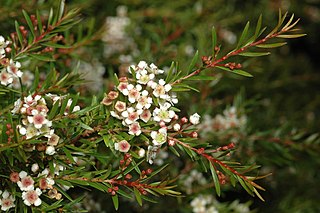
Sannantha bidwillii is a species in the myrtle family, Myrtaceae and is endemic to coastal Queensland in Australia. It is a shrub or tree with elliptic to egg-shaped leaves with the narrower end towards the base, and clusters of 3 white flowers.
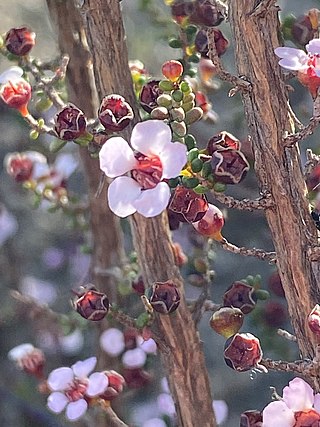
Rinzia orientalis, commonly known as desert heath-myrtle, is a species of flowering plant in the family Myrtaceae and is endemic to south-eastern Australia. It is a shrub with elliptic to narrowly oblong leaves and white or pale pink flowers usually with ten stamens.
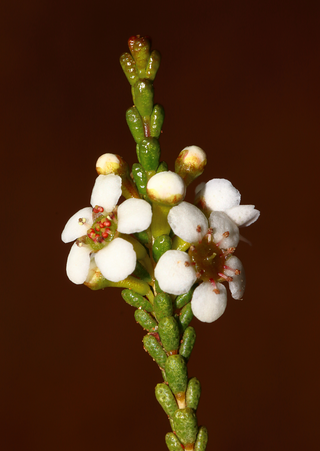
Micromyrtus clavata is a species of flowering plant in the family Myrtaceae and is endemic to inland Western Australia. It is an erect, compact or sprawling shrub with erect, egg-shaped leaves with the narrower end towards the base and small white flowers arranged singly in upper leaf axils.

Babingtonia camphorosmae, commonly known as camphor myrtle, is a species of flowering plant in the family Myrtaceae and is endemic to the southwest of Western Australia. It is a prostrate to low-growing shrub with linear to thread-like leaves and white or pink flowers in groups of up to five, each flower with ten to thirteen stamens.
Babingtonia erecta is a species of flowering plant in the family Myrtaceae and is endemic to the southwest of Western Australia. It is an erect shrub with densely clustered, linear leaves and white or pale pink flowers in groups two to seven in leaf axils, each flower with 8 to 14 stamens.
Babingtonia maleyae, commonly known as the Narrogin babingtonia, is a species of flowering plant in the family Myrtaceae and is endemic to the southwest of Western Australia. It is a compact shrub with narrowly egg-shaped to elliptic leaves and white flowers usually arranged singly in leaf axils, each flower with 17 to 20 stamens.
Babingtonia minutifolia is a species of flowering plant in the family Myrtaceae and is endemic to a small area in the southwest of Western Australia. It is an erect, widely spreading shrub with narrowly egg-shaped to elliptic leaves and pale pink flowers arranged singly in leaf axils, each flower with 16 to 19 stamens in a circle.
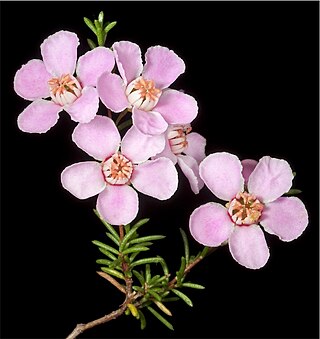
Babingtonia pelloeae, commonly known as Pelloe's babingtonia, is a species of flowering plant in the family Myrtaceae and is endemic to the southwest of Western Australia. It is an erect shrub with narrowly oblong to linear leaves and pink flowers usually arranged singly in leaf axils, each flower with 12 to 20 stamens in a circle.
Babingtonia triandra, commonly known as triplet babingtonia, is a species of flowering plant in the family Myrtaceae and is endemic to a restricted area of the southwest of Western Australia. It is a low, spreading to almost prostrate shrub with linear leaves and white flowers usually arranged in groups of up to 16 in leaf axils, each flower with 3 widely spaced stamens.
Babingtonia urbana, commonly known as coastal plain babingtonia, is a species of flowering plant in the family Myrtaceae and is endemic to the southwest of Western Australia. It is a shrub with linear leaves and white or pale pink flowers usually arranged singly in leaf axils, each flower with 16 to 20 stamens in a circle.

Sannantha crenulata, commonly known as fern-leaf baeckea, is a species of flowering plant in the myrtle family, Myrtaceae and is endemic to a restricted part of Victoria in Australia. It is an erect shrub with egg-shaped to round leaves with scalloped edges, and groups of usually 3 white flowers arranged in leaf axils.
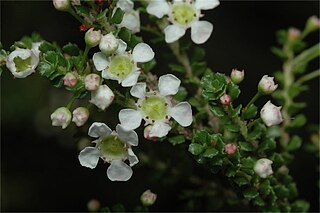
Sannantha cunninghamii is a species of flowering plant in the myrtle family, Myrtaceae and is endemic to eastern New South Wales. It is a shrub with round to broadly elliptic leaves with irregular edges, and white flowers arranged singly, in pairs or groups of three in leaf axils.
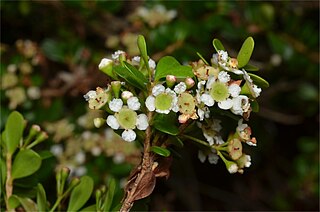
Sannantha tozerensis is a species of flowering plant in the myrtle family, Myrtaceae and is endemic to a small area of Cape York Peninsula in north Queensland. It is a shrub with elliptic to egg-shaped leaves, the narrower end towards the base, and white flowers arranged in groups of three or seven in leaf axils.

Micromyrtus striata is a species of flowering plant in the myrtle family, Myrtaceae and is endemic to eastern Australia. It is an erect to spreading shrub with overlapping egg-shaped leaves, and white to pinkish flowers arranged singly in upper leaf axils.















